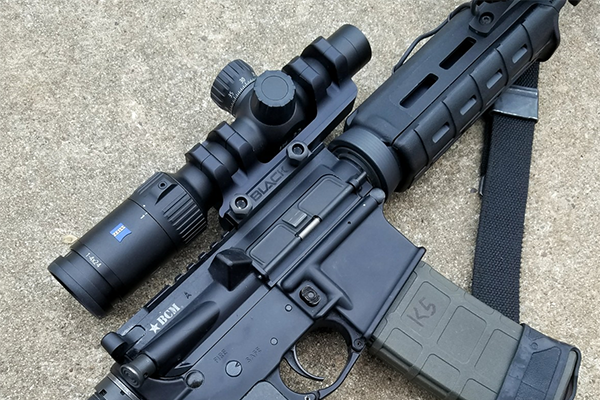
Last Updated on
By Kip Staton
I like small, handy rifles. I’ve owned AR-15s with fixed and collapsible stocks, and barrels ranging from 14.5” all the way to full sized 20” guns. And the one configuration I’ve had the longest is a simple, non-free floated 14.5” carbine-gassed upper with a basic M4 stock.
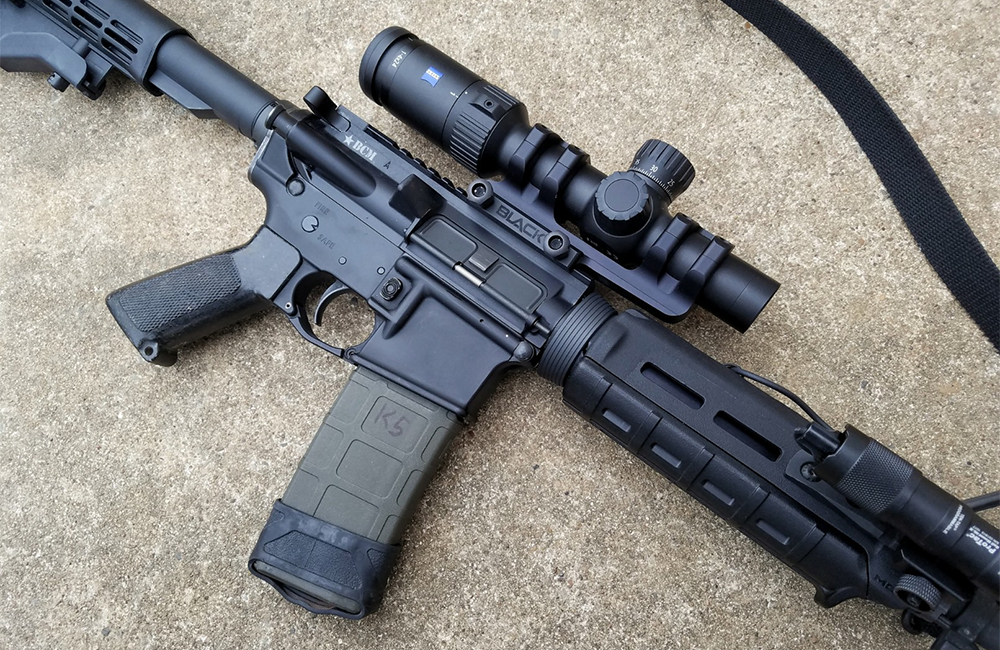
I know that an extended free floating tube is a better choice, but the truth is the plastic Magpul MOE MLOK handguards I installed haven’t really been an issue, especially since I primarily shoot the rifle 200 yards and in. After all, a standard AR-15 is far more accurate than most people give it credit for. The compact size, plain format and proven reliability of my little rifle just keep me coming back.
While I love “clean” guns, I also love optics. I’m well aware that iron sights give up quite a bit of efficiency compared to a good red dot, and even those lose out in many ways to today’s low-powered-variable-optics (LPVO).
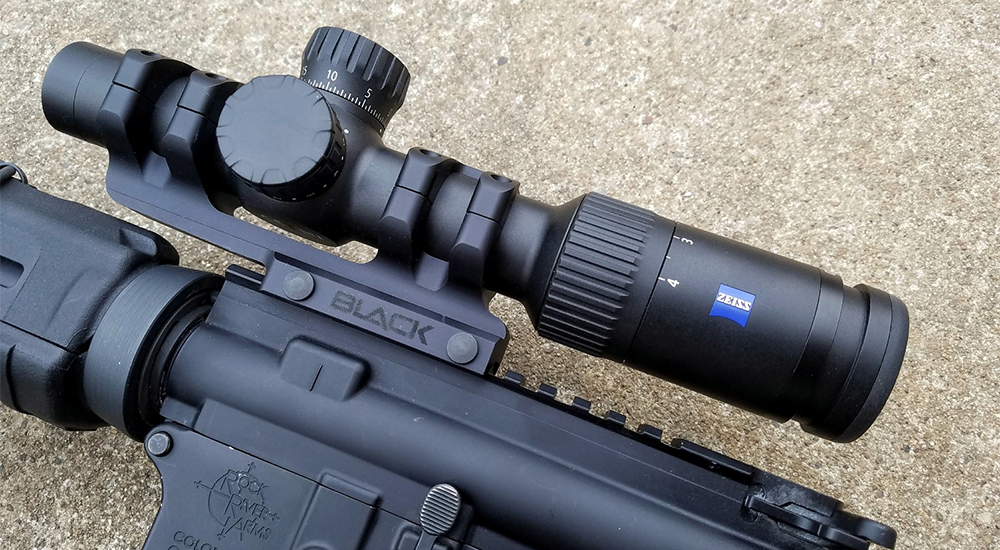
However, I dislike it when even a medium-sized scope ruins the lightweight, convenient feel of my favorite little rifle. And so when I had the chance to try out the Zeiss Conquest V4 1-4x24mm, I jumped at the chance. It looked tiny, with a lot of features to bring to the table.
And as it turns out, all of that was correct.
Zeiss Conquest V4 Series Overview
Like the name suggests, the Conquest V4 line is configured with a 4x zoom ratio. It also boasts a high light transmission rate of 90%.
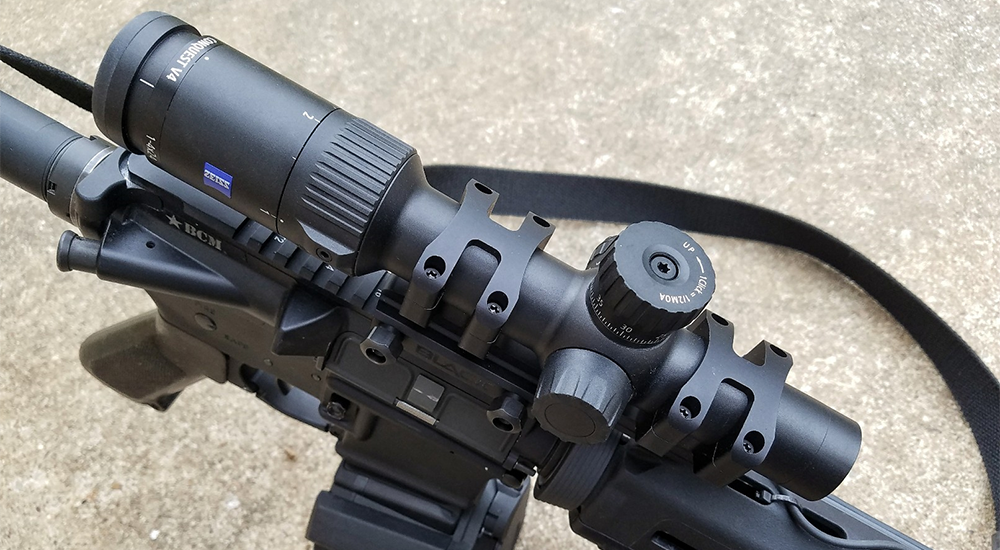
These optics stay true to the format most Americans are used to with .25 MOA click values and second focal plane reticles. Those reticles are available in several styles, designed for everything from hunting to competition use. Options in the Conquest V4 family include:
- 1-4x24mm
- 3-12x56mm
- 4-16x44mm
- 6-24x50mm
My sample 1-4x24mm optic was equipped with the ZQAR reticle, which is illuminated and designed to work with common 223 Remington and 308 Winchester loads. As an option, the 1-4×24 is available with or without a capped elevation knob. Mine was outfitted with the external locking target-style turret, complete with the Zeiss Ballistic Stop return-to-zero feature.
Unboxing and Physical Description
The Conquest V4 1-4×24 includes a set of simple bikini-style scope caps, double-ended adjustment wrench, large lens cloth, and an instruction manual. The first two things that stood out to me were just how short the optic really is, and the obvious level of quality.
- Magnification: 1-4x
- Objective Diameter: 24mm
- Field of View: 114’/28.5’ at 100 yards
- Tube Diameter: 30mm
- Eye Relief: 3.5”
- Eyepiece Outside Diameter: 44mm
- Weight: 17 Ounces
- Adjustment range: 100 MOA
- Exit pupil: 12.1mm/6.0mm
- Click value: ½ MOA
- Overall Length: 9.75”
It’s worth noting that the Zeiss Conquest V4 1-4×24 is only an inch longer than the shortest 1-4 scope on the market, the Nightforce NXS 1-4x24mm. This is a compact scope that’s right at home on an AR-15 or slim hunting rifle, yet it still manages to include an impressively well-executed feature set.
Illumination Controls
Mounted on the left side of the optic tube, the illumination controls are intuitive and crisp. A standard CR2032 cell is loaded into the compartment within the adjustment knob by removing the threaded cap.
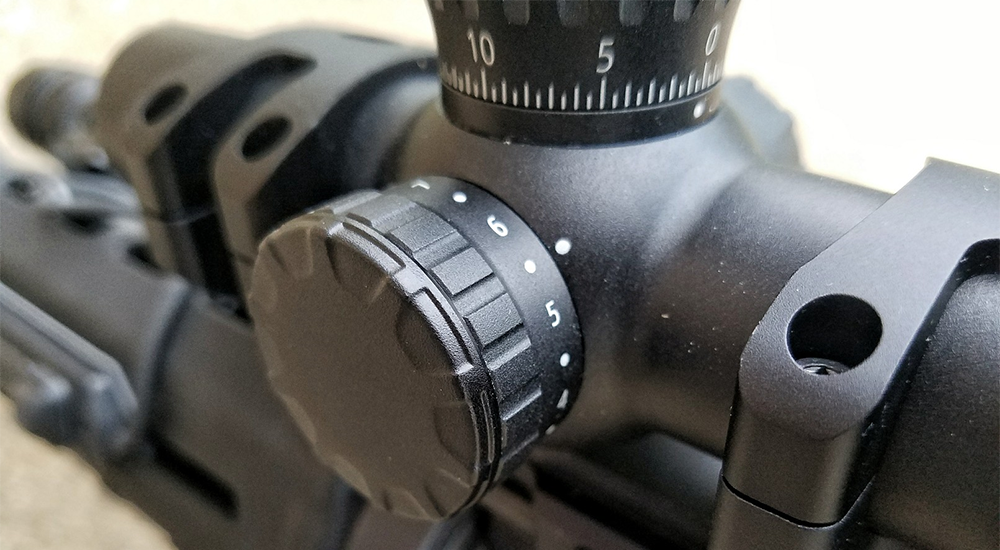
The illumination settings go from one to ten with an off position in between each number. The reticle is definitely day bright, but doesn’t get quite loud enough to bloom quite like an Aimpoint or Vortex Razor HD Gen II. It’s adequate, and the gentle glow on the lower settings is really useful when the sun hasn’t risen yet.
Comparative Optical Evaluation
I’ve written before about how I’ve struggled with this part of optics reviews, since glass quality can be really subjective. I experimented with various methods, including optometrist-style eye charts, but ultimately I think that they have all fallen short.
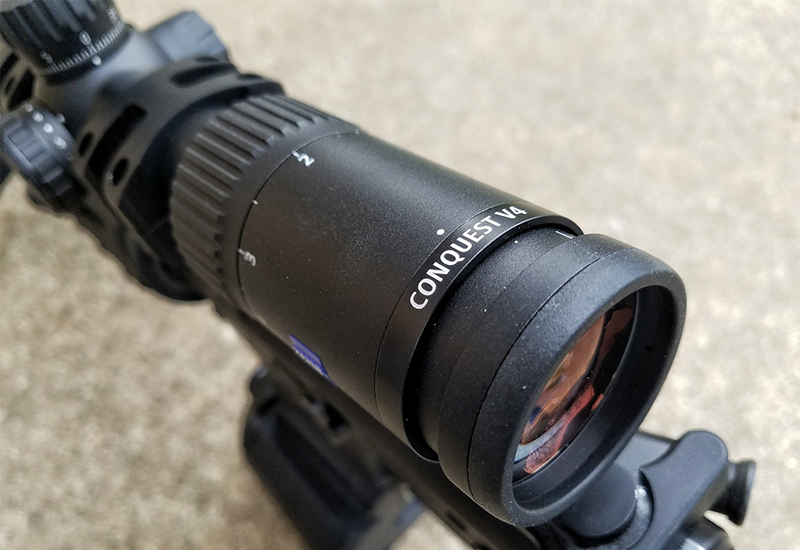
How can something as subjective as glass quality be communicated, especially when comparing many different brands and styles of optics? I think the answer may lie in converting the rather abstract discussion straight to the real world. Ultimately, why do we care about glass quality? I think the simple answer is that so we can see better, in order to hit what we need to hit.
So, to check the optical performance of the Conquest V4 1-4×24, I set up a 10” steel plate at 200 yards, 30 minutes before official sunrise. My thinking behind this is that all modern glass above a certain quality level is going to be more than fine during day use. Any significant performance differences or shortcomings are going to be most observable in low-light conditions.
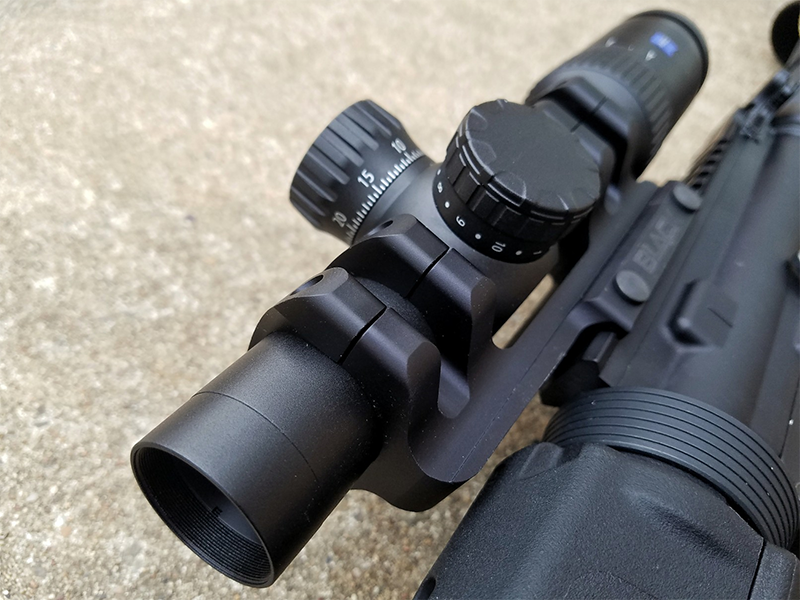
Pitch black shooting is best accomplished with more specialized tools, so I figure the “30 minutes before dawn” rule places the optical quality check squarely in the realm of the real-world use of most shooters, especially at 200 yards.
If I can make good hits from practical positions in that environment while clearly seeing and identifying the target, I think that tells you and me far more about the optical performance of a given optic than other more subjective means, like eye charts and me simply telling you it looks nice.
After all, the bullet doesn’t lie. And I’m not an optical lab, so I’m not going to pretend to be.
Long story short: there were no problems finding and engaging my light gray piece of steel against a dirt berm prior to the sun officially rising. This obviously makes the Conquest V4 a great choice for hunting.
The target edges were clearly defined, even in the reduced lighting. Zeiss claims that the Conquest series offers 90% light transmission, and I don’t have any reason to doubt it.
If you read this and think “heck, any scope could make those shots under those lighting conditions,” then you’ve found my conundrum. Most glass these days is excellent. Is this test the be-all-end-all measurement of glass quality? No. But I think it’s the most useful thing I can present to you, given the repeatability issues that I’ve run into with other comparison methods.
It’s good glass. If you’re missing your target while using a Conquest V4 scope, it’s not because of glass quality.
Turrets and Tracking Testing
Turrets on the Conquest V4 1-4x24mm are extremely well thought out, especially from a hunting and competition perspective. I think this part of the optic was executed perfectly, and is a stand-out feature.
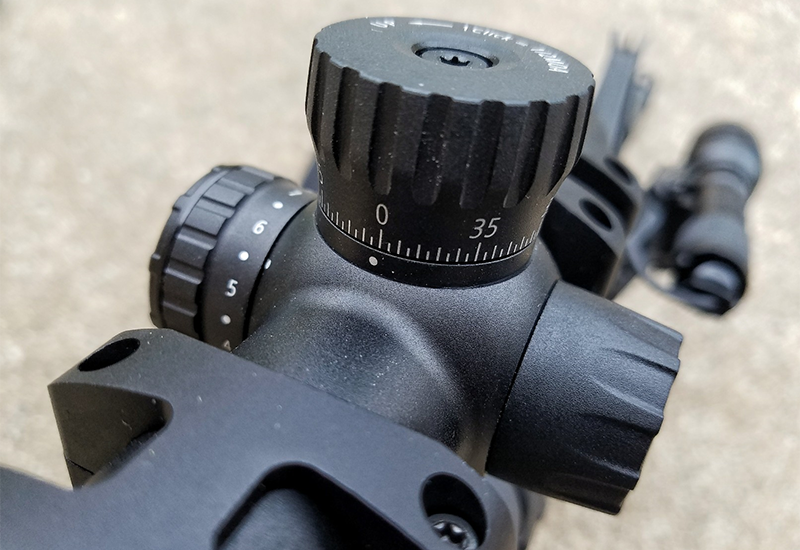
Zeiss was able to include most of the advantages of an externally adjustable elevation turret without introducing any of the liabilities associated with an uncapped turret on a 1-4x carbine optic. It offers a single rotation of adjustment with up to 35 MOA of range within that single turn.
This limited rotation keeps you from getting lost, as does the clever Ballistic Stop. Even though it’s just a single rotation, it’s still enough to get my 14.5” carbine out to 750 yards (according to my Kestrel wind meter), with 55 grain ball ammunition.
To top all of that off, it’s locked down until you pull firmly upward, at which point it stays up for the clicking. Resetting the knob back to zero after zeroing is as easy as removing the single large Torx-head screw, removing the knob, setting the zero stop, and replacing the turret at the zero mark.
The zero stop has no moving parts or shims to reset, as a function of the single turn turret design. It simply interfaces with a fixed post around the circumference of the housing, and limits rotation past a certain point. It’s an extremely clever design.
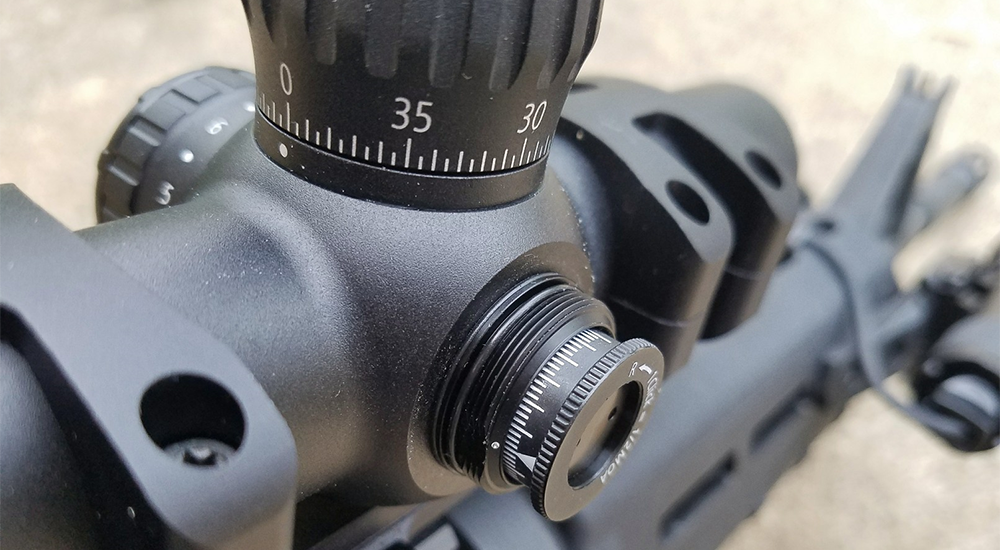
The windage knob is miniscule in comparison to the elevation adjustment, and hides well underneath a thick polymer cap. There are no numbered markings, and resetting it is as easy as pulling the turret up, moving the (now freely spinning) turret back to zero, and letting it go back down under spring tension.
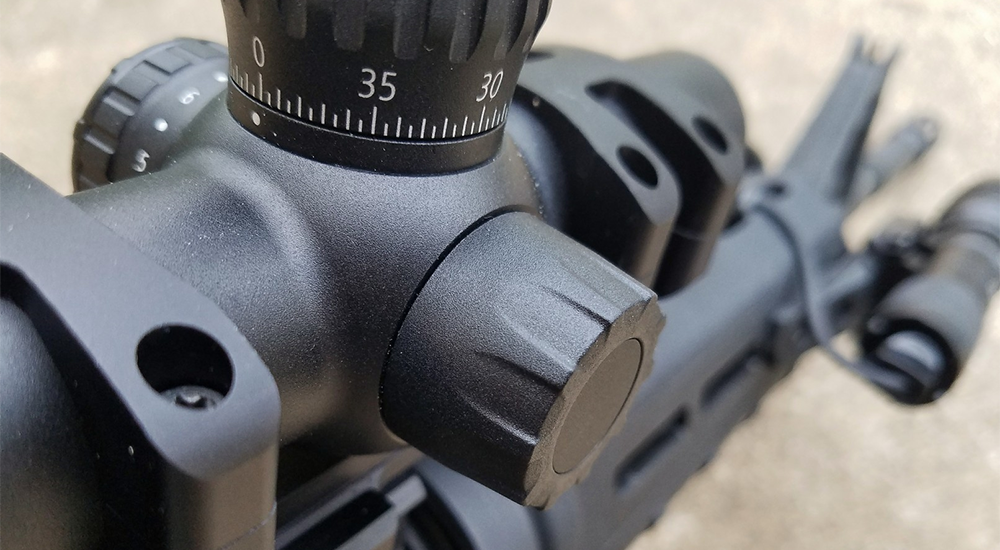
It’s rather spartan compared to the elevation turret, and that’s ok. I usually hold for wind adjustments, since they can change so frequently. This style (large, well-thought out elevation knob and capped windage adjustment) is becoming more and more common on practical optics, which in my mind is a great thing.
Testing the tracking against a tall scaled target at 100 yards showed no surprises: The Conquest V4 tracked perfectly, down to the click. I would feel comfortable using the clicks at distance without any sort of correction formula applied.
Zeiss Conqest V4 1-4x24mm ZQAR Reticle
I really like this reticle. It has a calibrated drop portion down the center, as well as a split horseshoe-and-dot above for primary aiming. This ballistic portion of the reticle is bracketed by heavy tapered bars on the right and left, shown below at 50 yards. The split horseshoe is exactly the same size as an NRA B-8 target repair center at that distance.
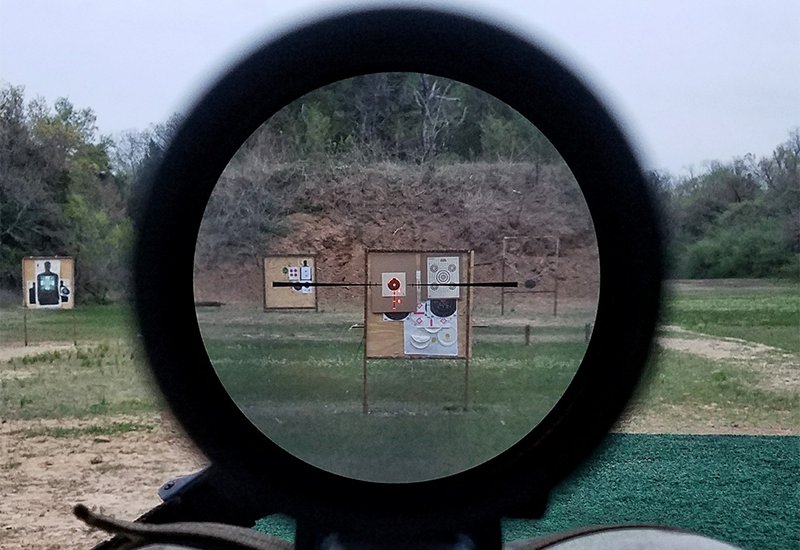
These brackets are awesome for quick sight pictures up close, where you don’t necessarily need the precision of the 1.5 MOA center dot. It’s an old concept, but it works well at the 1x setting of the Conquest V4 1-4×24. Reticle focus is managed via an adjustable ring on the rear of the ocular lens.
The front sight tower makes the sight picture appear non-usable in the photo below, but that’s just how the camera had to focus to show the true 1x viewpoint. It’s a non-issue in use, with the human eye.
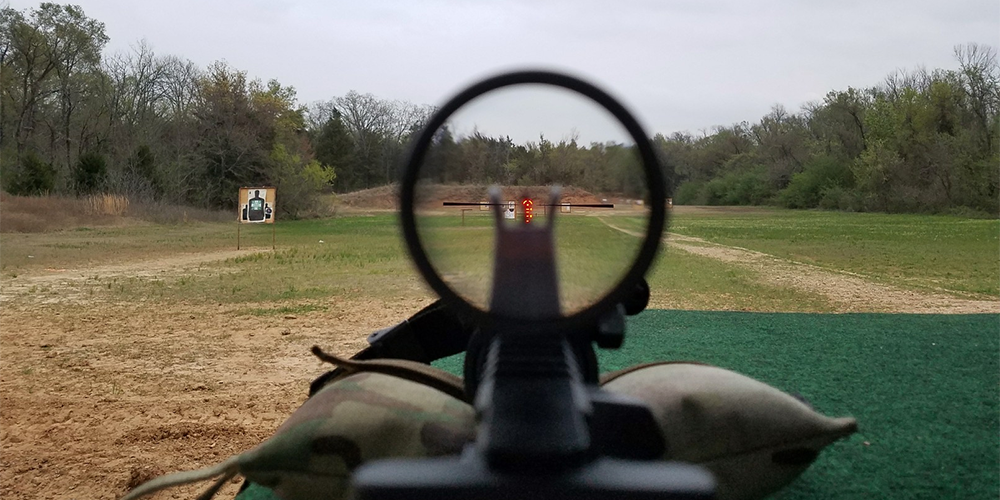
On my rifle, the BDC provides these holdovers with 55 grain ball ammunition – 55 Grain XP193, with 100 Yard Zero:
- Top of vertical line: 179 yards
- “4” hashmark: 207 yards
- “4.5” hashmark: 240 yards
- “5” hashmark: 256 yards
- “5.5” hashmark: 275 yards
- “6” hashmark: 290 yards
- “6.5” hashmark: 310 yards
- “7” hashmark: 326 yards
It’s a little confusing that the numbers don’t equate to hundreds of yards, but it is what it is. This translates to a roughly 300 yard reticle, with a 100 yard zero. Switching to a 50 yard zero stretches the bottom hashmark out to 350 yards, which isn’t too much of an improvement. Of course, you always have the external turret if you need to reach out further.
For lightweight carbines like mine, 300 yards is a respectable limitation with the reticle. I rarely shoot out that far with this gun, so it’s not too big of an issue for me.
The below photo shows the reticle view just to the right of the 100 yard target frame, with the illumination on the max setting on a partly overcast day. It’s bright enough to show around the edges of the glass, but doesn’t bloom obnoxiously in the reticle.
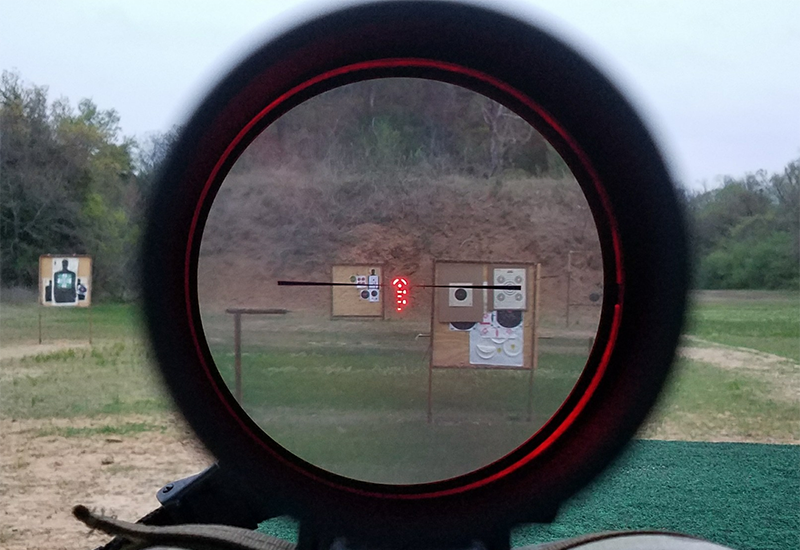
Zoom Ring
There’s nothing really to write home about here. The zoom ring is low profile, offers a nub for extra purchase during turning, and isn’t too stiff or loose. Oddly, the 1x marking is on the right-hand side of the housing, instead of 12:00 on the top like I’m used to seeing.
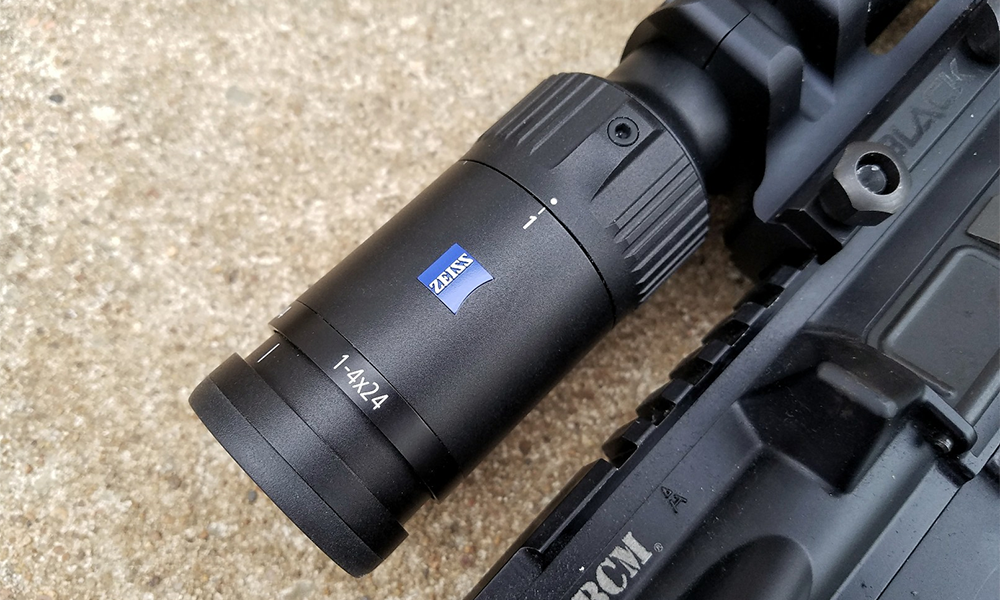
Zeiss does have a throw lever available, should you desire to add one. I didn’t find it necessary.
Zeiss Conquest V4 1-4x24mm Riflescope In Use
I mounted the Zeiss Conquest V4 1-4x24mm with a Nikon BLACK cantilever scope mount. I’ve been able to use these mounts with several different optics on my AR-15, and continue to be impressed. They are a definite improvement over Nikon’s previous one-piece mounts, in terms of features, fit and finish.
Note how the mount positions the ocular lens even with the rear of the receiver, yet the objective lens protrudes only a short distance past the rear of the handguard. Yep, it’s a short optic!
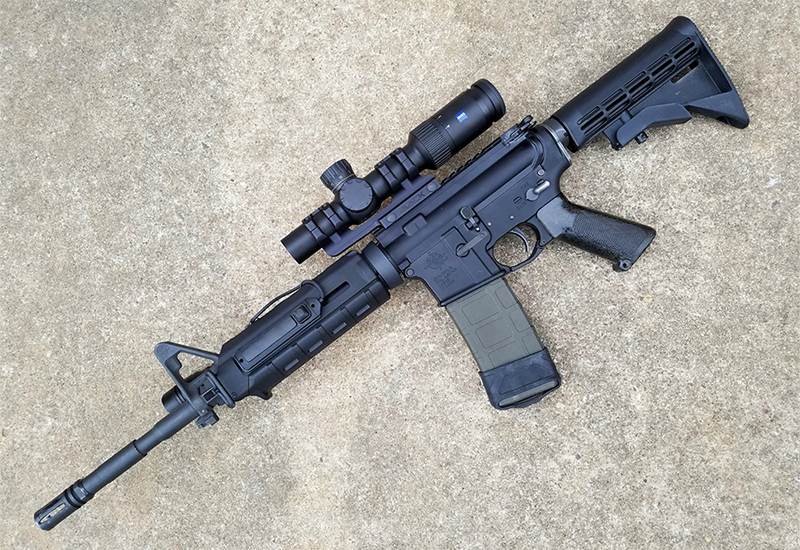
I set the eye relief, torqued everything down with my Wheeler digital FAT wrench, and prepared my range gear for a week of morning drills. I shot the Conquest V4 1-4x24mm at distances ranging from 10 yards to 200 yards, on standard NRA B-8 repair centers and a 10” AR500 steel plate.
At 1x, my times for 10 shots at 25 yards on a B-8 center were identical to those with my Aimpoint, from the low ready with the safety on. At 200 yards, shooting with only the magazine as support was uneventful. It just plain works, and works well.
I didn’t really need to dial the turret with the convenience of the reticle, but I did to see how it works while using the optic. Clicks are distinct and easy to feel, even while wearing gloves. The turret is also easy to see and read while behind the gun.
Rarely do I find an optic that I don’t have any criticisms or nitpicks with, but I think this is one of them. I did find myself wishing at times that the magnification topped out at more than 4x, but that’s really not the fault of the optic. It truly is a class act on the range.
Warranty
Zeiss covers the Conquest V4 line with their limited lifetime transferable warranty, as well as the Five-Year No-Fault policy. If there’s an issue with the scope due to workmanship, they will make things right. Furthermore, the Five Year No-Fault policy means that if you damage the scope during normal use within the first five years, they will replace or repair it at not cost.
You do need to make sure to register your scope within the first 60 days after purchase in order to be covered by the Five Year No-Fault policy. Of course, it doesn’t cover intentional abuse or neglect. Find all the details on the Zeiss Conquest V4 warranty here.
Is the Zeiss Conquest V4 1-4x24mm for You?
I recently took a look at the Vortex PST II 1-6×24, and I would say that it is right on the border of the size I’m comfortable having on this rifle. Any bigger, and that’s too big. I also did a recent overview of the Trijicon TA33, which I believe is pretty much the ideal size for an AR-15. It just barely alters the handling characteristics.
The Conquest V4 is somewhere in between those two. Granted, the V4 1-4x24mm is definitely more capable than an ACOG, and gives up some magnification compared to the PST II 1-6. But he slight increase in footprint over the TA33 is made up for in overall capability, and it’s frankly just more fun to use the rifle with the short V4 as compared to the PST II.
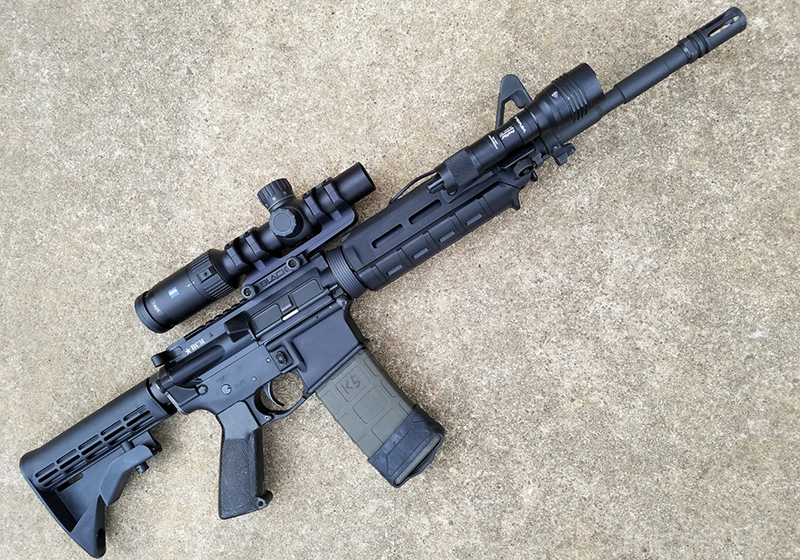
I do not pretend to know anything about the tactical world, and deployment of optics in that arena. But I do know that the idea of a police designated marksman is gaining ground in certain circles. This would certainly seem to be a realistic contender in that role, given the generous eyebox at 1x, field of view at 4x, day-bright illumination, consistency in tracking, and compact dimensions. I can’t speak to the suitability of the reticle for that use case, but it seems like it would work just fine.
In fact, those attributes would make it right at home on a general-purpose hunting or ranch rig as well.
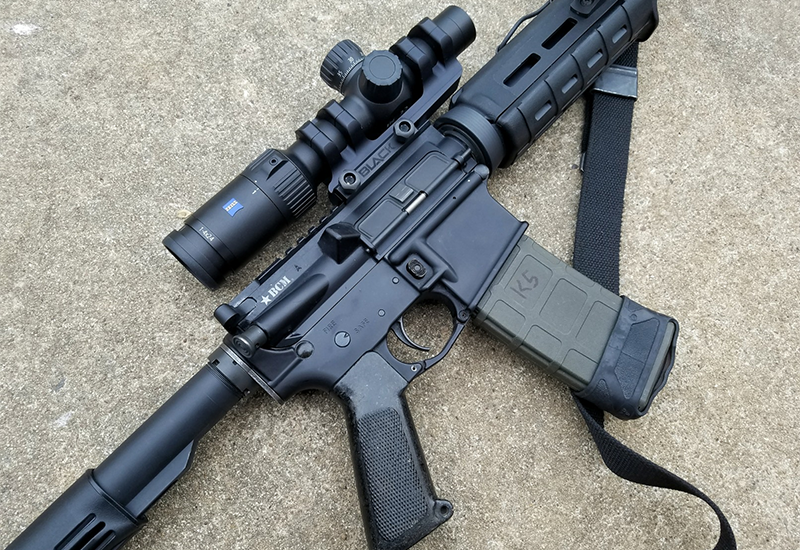
As far as downsides go… I really can’t find any. Sure, the 1-4 power is somewhat dated in this era of 1-6x and even 1-8x optics, but for me, that’s not really a downside. Especially when the size of the optic is factored in.
Nightforce has done some incredible things with compact 1-8x scopes recently, and I definitely think that’s where the industry as a whole is headed. But right now, those choices are rather expensive. And while the Conquest V4 isn’t exactly a cheap scope, it’s definitely more attainable for the serious enthusiast.
For the included feature set and optical quality, I don’t think there is an equal 1-4x scope for the money.
Zeiss Conquest V4 1-4x24mm Review Final Thoughts
I hate to sound like a broken record, but we’re in a golden age of optics engineered with the AR-15 in mind. The Zeiss Conquest V4 1-4×24 brings a lot to the table in a crowded market, but I believe it’s a solid choice for users wanting a mid-priced, high-end, reliable variable-powered optic that doesn’t ruin the nimble nature of the AR-15.
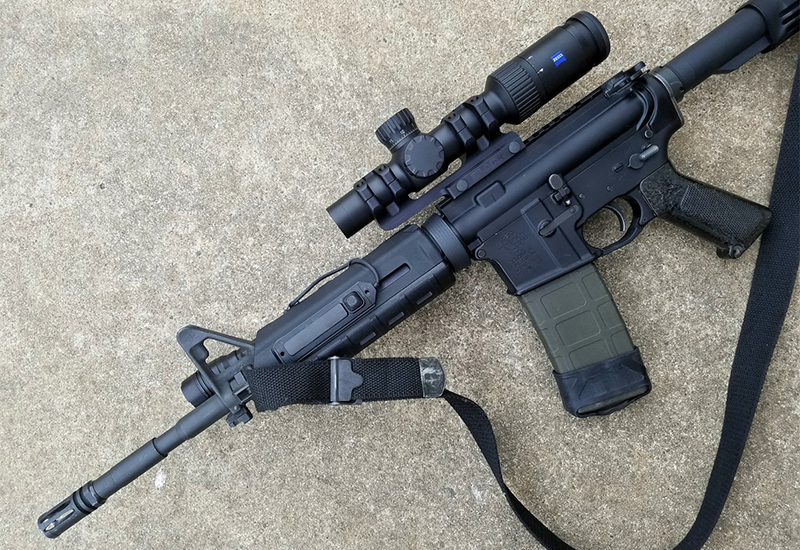
Add this one to the list of good general-purpose optics for your AR-15. It’s a real winner.




Leave a Reply